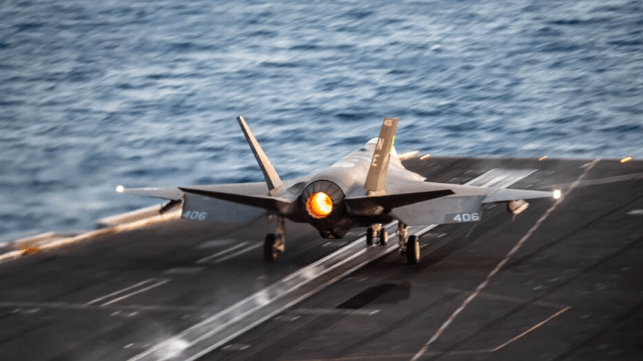U.S. Mounted Huge Forward Deployment for Attack on Iran
Now that the Trump administration has carried out a strike, all eyes are on the Strait of Hormuz

The United States mounted an enormous deployment of aircraft and naval vessels into the Central Command area of responsibility in preparation for its attack on Iranian nuclear enrichment sites at Fordow, Natanz and Isfahan. Little of this massive deployment was disguised, with multiple recordings of military movements by both casual observers and open source observers. But while the movement was almost advertised, the United States nonetheless appears to have achieved tactical surprise, which is a considerable and complex achievement for operational security planners.
Satellite imagery shows damage to the Fordow Nuclear Facility in Central Iran, following last night’s strikes against the underground complex by the U.S. Air Force. At least six impact sites from 12 GBU-57A/B MOP (Massive Ordnance Penetrator) 30,000lb “Bunker Buster” Bombs… pic.twitter.com/5d6CGiq8B8
— OSINTdefender (@sentdefender) June 22, 2025
Aircraft flew to the region both from the East and from the West, staging through American island bases in the Pacific, RAF bases in the United Kingdom, plus US bases in Italy (Aviano), Germany (Ramstein) and Greece (Chania).
US B-2 bombers left Honolulu apparently loaded with weapons, as supposedly signaled by their need to refuel as soon as they reached cruising altitude; the weight of the ordnance on board, open-source observers suggested, would have prevented take-offs with a full fuel load. This movement was heavily supported by US tanker aircraft., with all movements visible on public flight-tracking websites. This was a feint: The B-2 force that actually conducted the attack split off and flew eastwards from Whiteman AFB, Missouri on a non-stop flight directly to the target, defense officials confirmed to the Wall Street Journal. The westbound force reportedly had no operational involvement beyond diverting attention from the real attack.

Route of the real strike package (Courtesy DOD)
Squadrons of F-22 stealth fighters, with accompanying KC-46 refueling aircraft, were seen transiting through RAF Lakenheath en route to the region.
An airbridge from US bases in both the United States and Europe was mounted with C-17 aircraft, reinforcing in particular US bases in Saudi Arabia and Jordan. Over the last 72 hours, typically ten such aircraft have been in the flow at any one time.
Destination airfields in the region have become very crowded. Partisan reporters @MenchOsint captured at least 22 KC-135s, 53 F-16s and 10 C-130 crowded into Prince Sultan Air Base on June 19, some of which may have evacuated from the Al Udeid airbase in Qatar, probably too close to Iran for comfort. The future of the Al Udeid airbase must now come into question, given Qatar’s condemnation of the US attacks.
Almost every single large military aircraft parked at Al Udeid Air Base in Qatar evacuated the installation this week, with over 34 aircraft repositioning to other bases further from Iran.
— OSINTtechnical (@Osinttechnical) June 19, 2025
The US confirmed that it moved some assets "vulnerable to Iranian attack." -Reuters pic.twitter.com/DkaVAUz6s9
The US naval deployment in the region has been anchored on two carrier strike groups (CSGs). The USS Nimitz (CVN-68) is completing its redeployment from the Pacific and the USS Carl Vinson (CVN-70) has now been on station in the Arabian Sea for several months. Neither of these two CSGs appears to have been directly involved in the strikes on the nuclear targets. The immediate US Navy contribution appears to have been a salvo of 30 Tomahawk missiles fired by submarines, which would have needed to be positioned within 1500 miles of the target - by deduction, therefore, in the northern Arabian Sea.
Imagery from Isfahan Nuclear Facility, where US Navy launched 30 Tomahawk Cruise Missiles. pic.twitter.com/ufhnOEJXAo
— MenchOsint (@MenchOsint) June 22, 2025
The two CSGs, plus the bulk of the other reinforcements coming into theater, will come into their own if this initial strike and show of force fails to deter Iran and its proxies from mounting retaliatory attacks on US targets in the region.
In the meantime, five Arleigh Burke destroyers armed with SM-3 anti-ballistic missiles are positioned in the Eastern Mediterranean: USS Paul Ignatius (DDG-117), USS Oscar Austin (DDG-79), USS Arleigh Burke (DDG-51), USS Thomas Hudner (DDG-116) and USS The Sullivans (DDG-68) are deployed to thicken up Israel’s anti-missile defenses. A further two Arleigh Burke destroyers (USS Forrest Sherman (DDG-98) and USS Truxtun (DDG-103) are performing the same role from the Red Sea, positioned to deal with the continuing Houthi threat to Israel. After the American strike, a Houthi spokesman has already shouted out a declaration of war on the United States, ending the Omani-mediated ceasefire agreed at the beginning of May.
As of Sunday, Iran has not yet mounted any form of retaliatory attack outside its established target deck in Israel. Immediate fears are focused on a closing of the Straits of Hormuz, which the Iranian Parliament has just recommended should be closed. One product tanker, the Kohzan Maru (IMO 9209283) in the minutes after news of the attack became public, conducted a most unorthodox U-turn even though it had already entered the Traffic Separation Scheme, and then retreated south-east. Understandable nerves and uncertainty within both the maritime and insurance communities may result in a de facto closure of the Straits before the Iranian National Security Council determines what to do.
At least one tanker in the Strait of Hormuz appears to have paused its transit after the US struck Iran overnight.
— OSINTtechnical (@Osinttechnical) June 22, 2025
Seen here, the UK-flagged tanker Kohzan Maru reversed course after the strikes became public and is now racing south at top speed. pic.twitter.com/xugD83AoEZ
